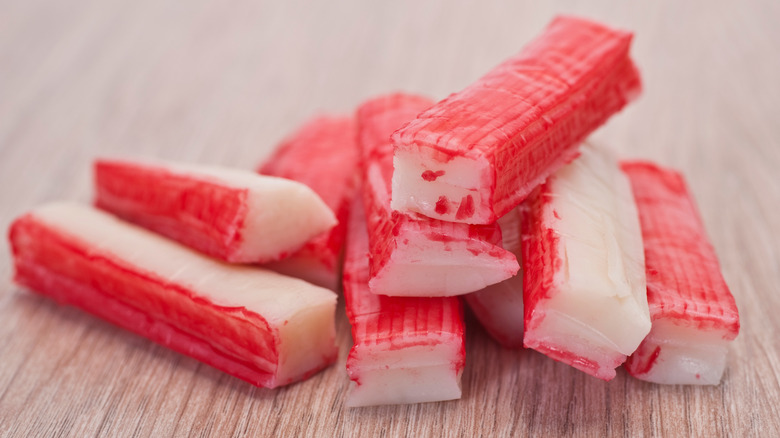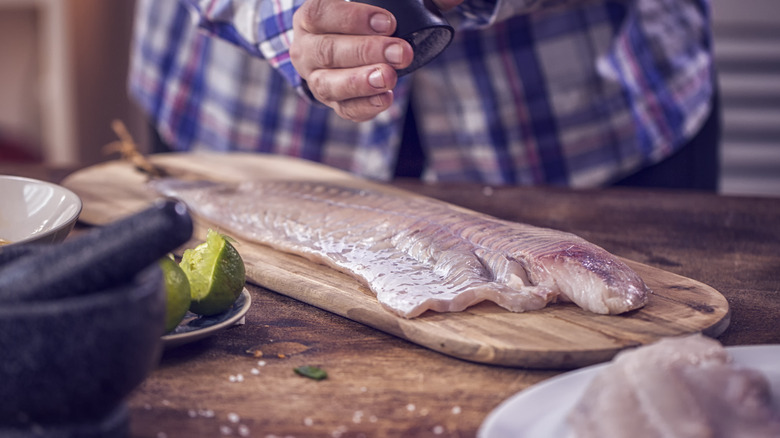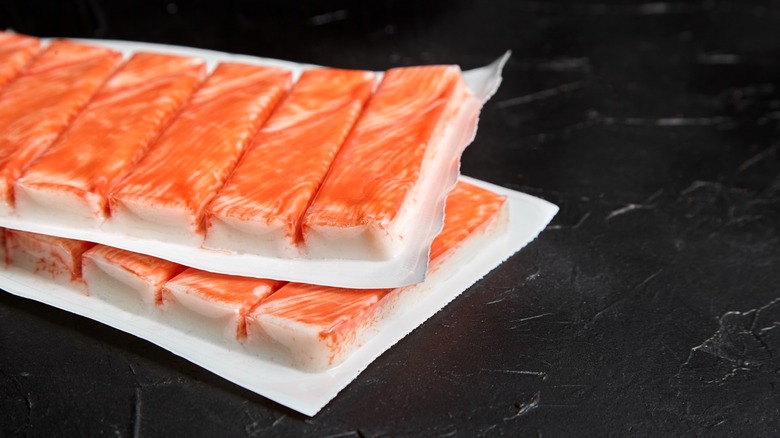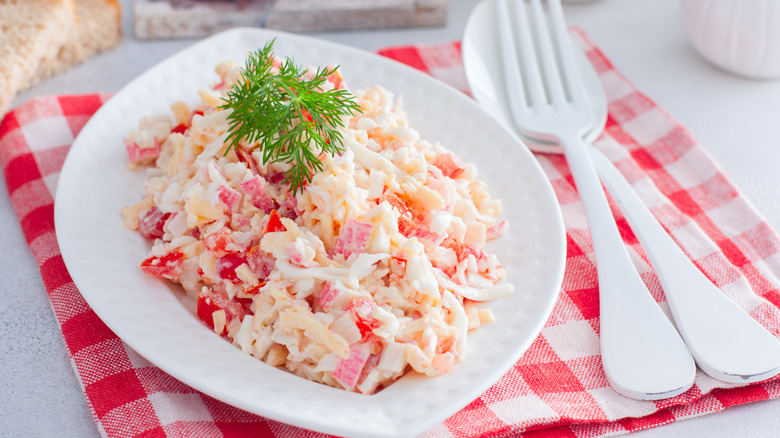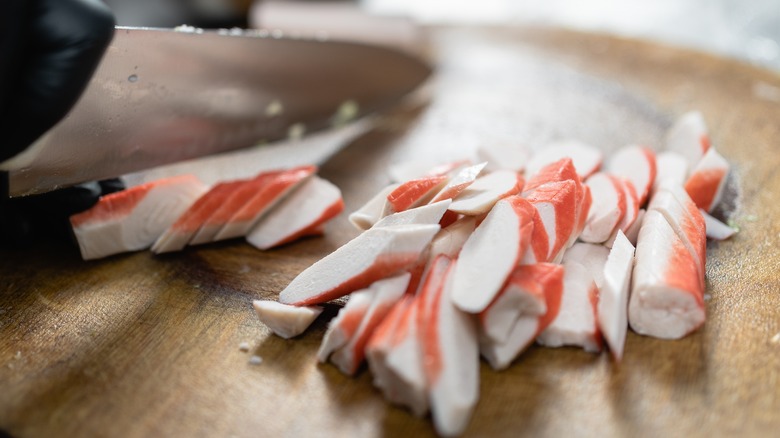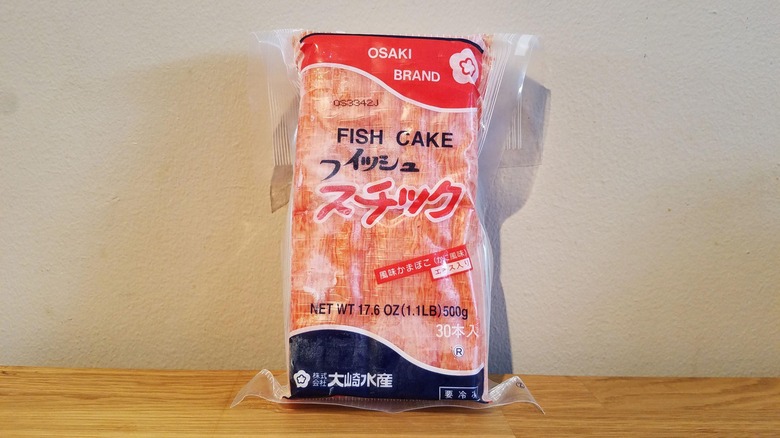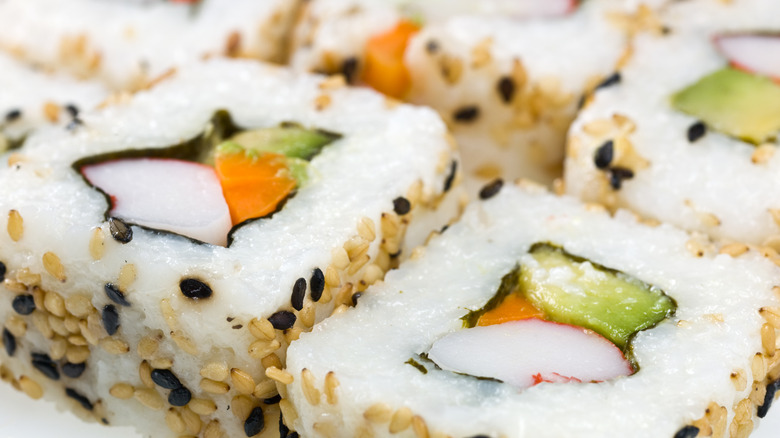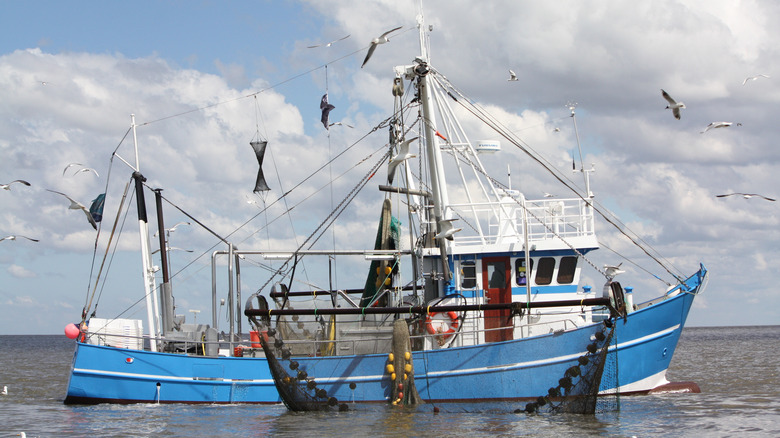Here's What You're Really Eating When You Bite Into Imitation Crab
Imitation crab is known by many names, though none of them are particularly descriptive. Monikers like "krab," crab-flavored seafood," and even "the hotdog of the sea" add an air of mystery that often leaves shellfish enthusiasts wondering exactly what comprises this ingredient. So what are you really eating when you bite into imitation crab? Here's a hint: it is definitely not vegetarian.
When it comes to imitation crab, Western eaters who aren't familiar with the ingredient tend to have a lot of common questions. Even those who have already taken a deep dive into the world of imitation crab may wonder about its environmental footprint or the slew of brands that are available. As its worldwide ubiquity suggests, this ingredient has more historical, nutritional, and culinary value than one might expect a type of mock seafood to have. Our humble opinion is that imitation crab is more than just a budget substitute for real crab. In fact, it is a worldwide phenomenon in its own right.
Imitation crab is mostly Alaskan pollock
Although there is a common misconception that imitation crab is made from something wildly foreign, it is actually made from a minced fish paste called surimi. Surimi is typically made with Alaskan Pollock, which is deboned, washed, and then minced. The resulting paste is then usually blended with water; starch (usually potato, wheat, corn, or tapioca); protein (usually egg whites or soy); sugar and sorbitol; oil (usually vegetable, sunflower, or soybean); and salt. The end result is imitation crab. Modern manufacturers often add additional colorings, preservatives, and flavorings, such as crab extract, but the core recipe is largely established.
As a processed food, surimi can be found in many different forms. It can be pressed into chunks for dips and spreads. It can be pushed into sticks and served alongside cocktail sauce as an appetizer. It can be shredded and served in tacos or crab cakes. It can even be pressed into a crab leg shape for use in soups. Its flexible nature is just as important as its relatively low cost when it comes to its popularity.
Your imitation crab could be mislabeled
While the ingredients for imitation crab seem relatively clean on paper, the messy reality of commercial fishing means that you cannot always rely on surimi to be made from the ingredients listed. In fact, scientific research indicates that mislabeled seafood is a widespread issue throughout the global market.
A 2017 study published in PLOS ONE tested sixteen surimi products from non-EU countries and found that 37.5% were mislabeled. Of these, 25% declared an incorrect fish species, and another 25% failed to report the presence of mollusks. This creates both allergy risks and food safety concerns among consumers of surimi. One particularly relevant risk is the possible contamination of ciguatera poisoning, one of the most frequently reported seafood-based illnesses. If a surimi product includes a species of fish that is more likely to be contaminated with ciguatoxins, it poses an undue risk to the consumer.
Thankfully, the chance of contracting ciguatera poisoning from seafood is relatively low, and the chance of dying from such poisoning is less than 0.5%. That said, this is still something to be aware of if you are a regular consumer of imitation crab or other processed seafood.
Imitation crab has less nutritional value than real crab
One of the downsides of imitation crab is that it is lacking in vitamins, minerals, and omega-3 fatty acids compared to real crab. So, while it is far from the unhealthiest food out there, choosing imitation crab over real crab means making some concessions in the nutritional department.
Since there are many different kinds of imitation crab and even more species of real crab, it is hard to say exactly how wide the disparity is. However, we can use data from the U.S. Agricultural Research Service's FoodData Central to compare how two identical portions of these two foods compare nutritionally. According to the ARS, a 100-gram portion of imitation crab contains 15 grams of carbohydrates, while the same portion of Alaskan King crab contains none. Imitation crab contains 6.25 grams of sugar, while real crab contains none. Meanwhile, Alaskan King crab contains considerably more calcium, protein, and potassium. The only thing working against real crab is that it also contains significantly more sodium (1070 milligrams versus 529 milligrams).
Again, imitation crab is not terrible for you, but it is undeniably inferior in terms of overall nutrition. So unless you are specifically watching your sodium intake, real crab is the more wholesome choice.
What you're trying could taste better than the real thing
One misconception about imitation crab is that it is inherently lower-quality food than real crab. Don't get us wrong — real crab is a delicious delicacy. However, its massive price discrepancy compared to imitation crab is mostly because crabbing is labor-intensive and relies on a healthy natural crab population. It has nothing to do with imitation crab being a less desirable food. Point in case it is hotly desired in Japan.
In Japan, imitation crab (or kamaboko) is primarily viewed as its own discrete type of street food rather than a substitute for real crab. At Tokyo's famous Tsukiji Fish Market, you'll find rows of vendors serving kamaboko skewers alongside other street food staples like takoyaki (fried octopus balls) and okonomiyaki (savory pancakes).
In America, street food may be perceived as unclean and of low quality. But in Japan, even convenience store food is highly regarded. And street food? It is often elevated to rival restaurant meals. So, who is to say that a corn dog from a county fair is inferior to a ribeye steak? Sure, one is more processed than the other, but they can both delight the taste buds in radically different ways.
But not all imitation crab is created equally
Although there is a lot to passionately defend about imitation crab, there are caveats. The pre-packaged imitation crab you bought at the grocery store is probably not going to rival kamaboko made with fresh-caught fish from a Japanese seafood market. In reality, imitation crab products come in a wide spectrum of quality, with your geographical location playing a major factor. To illustrate this point, consider the varying virtues of a few different brands of imitation crab.
Osaki Fish Cakes are imitation crab sticks used for cooking and snacking. This brand comes in individually packaged, shredded sticks, which enhances the texture and makes them easier to defrost in portions. They bring that delicate, smooth texture with a hint of sweetness to any dish you add them. There is a night-and-day difference when you compare Osaki Fish Cakes with the flake-style imitation crab that you commonly find at U.S. grocery stores, such as the imitation crab meat sold by Panamei Seafood. This brand is often overly sweet and with a with a rubbery texture, perhaps due to rice leavening.
This is not to say that Osaki Fish Cakes is the only good imitation crab product you will find stateside, nor that all U.S.-based brands of imitation crab should be avoided. However, perspective is important when considering the flavor and quality differences you can expect from imitation crab. It also demonstrates that imitation crab is not always as good as real crab.
Imitation crab is used in many recipes
If you need any further evidence that imitation crab is just as valid of an ingredient as real crab, consider that many popular recipes specifically call for it. This should come as no surprise, though, as surimi is a traditional Japanese method of food preservation that dates back over 1,000 years. Consequentially, you will find plenty of Japanese recipes that specifically call for this ingredient, particularly in the category of Japanese fish cakes. Surimi is used to make narutomaki, chīkama, chikuwa, jakoten, sasa, satsuma, and hanpen, among others.
The examples go beyond Japanese cuisine as well. Most crab rangoon recipes specifically suggest using imitation crab instead of real crab. This is because the cream cheese and fried wonton wrappers will overpower the delicate flavor of real crab. Another example is the California roll. A classic California roll recipe remains faithful to the original ethos of this dish, which was initially designed to be more palatable to North Americans who weren't used to eating fish-forward dishes. All this said, none of these dishes will be ruined if you prepare them using real crab — unless you truly hate the flavor of real seafood.
It is just as environmentally destructive as real crab
Another misconception about imitation crab is that it is an environmentally friendly alternative to real crab. Unfortunately, it is, and it isn't. Let's start with how it is. Imitation crab relieves some of the demand for real crab, which is a rapidly dwindling resource in light of climate change. For example, the population of snow crabs in the Bering Sea has declined by over 10 billion crabs (90%) from 2018 to 2021 alone due to sea warming. While creating imitation crabs relieves pressure from struggling species like these, it, unfortunately, comes with its own environmental impacts.
Because imitation crab is a processed food, its environmental impact is considerably larger than that of real crab. A 2019 study published in Elementa: Science of the Anthropocene conducted a carbon footprint analysis of seafood products from Alaska pollock, revealing that the processing phase of their manufacture had nearly double the climate impact as the fishing phase alone. So, while imitation crab helps restore the dwindling population of saltwater crabs, it is not exactly what you might call an eco-friendly food.
Thankfully, you can find sustainably sourced versions of both imitation crab and real crab, so discerning customers can enjoy these sumptuous seafood without further contributing to either issue.
